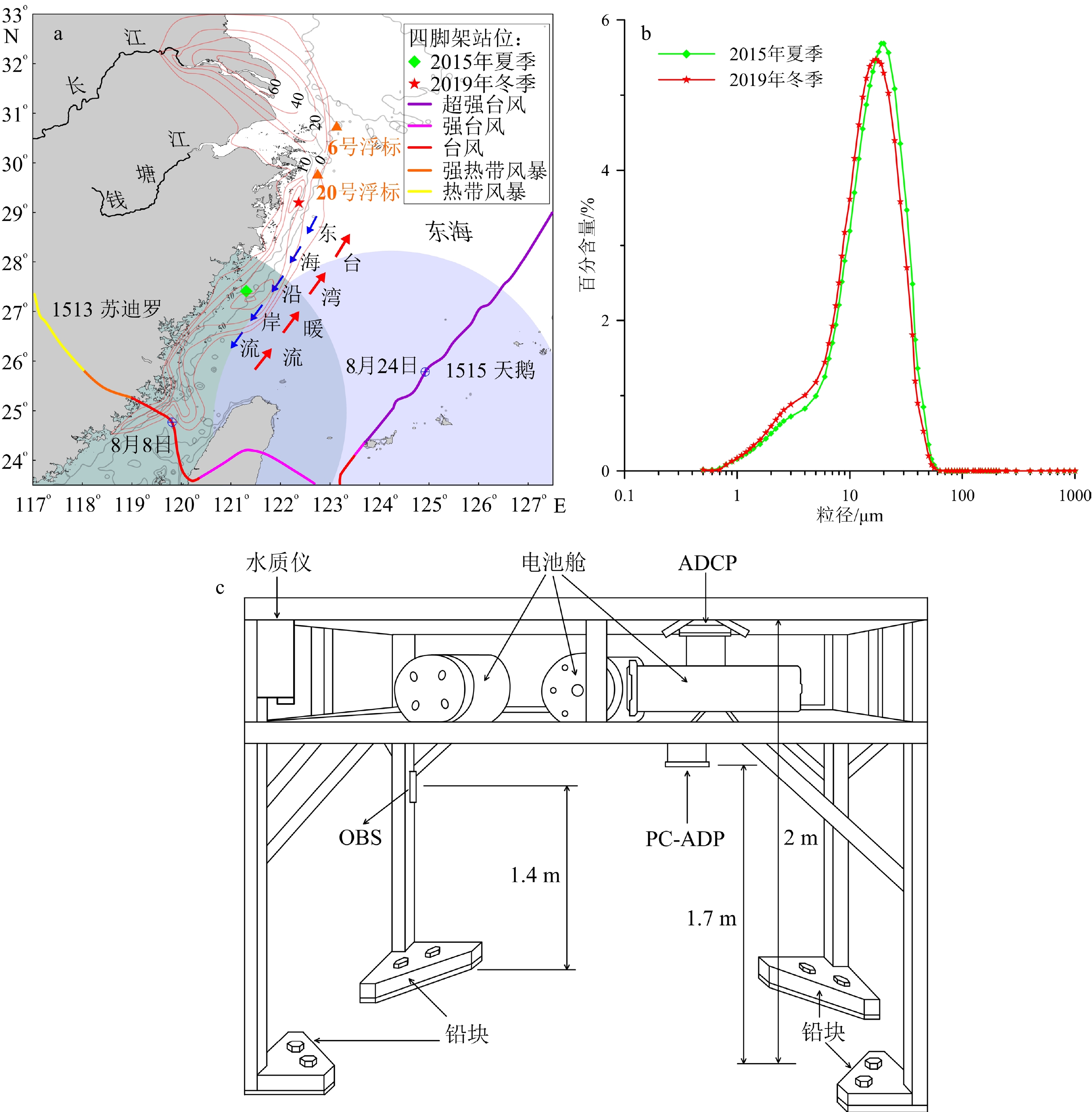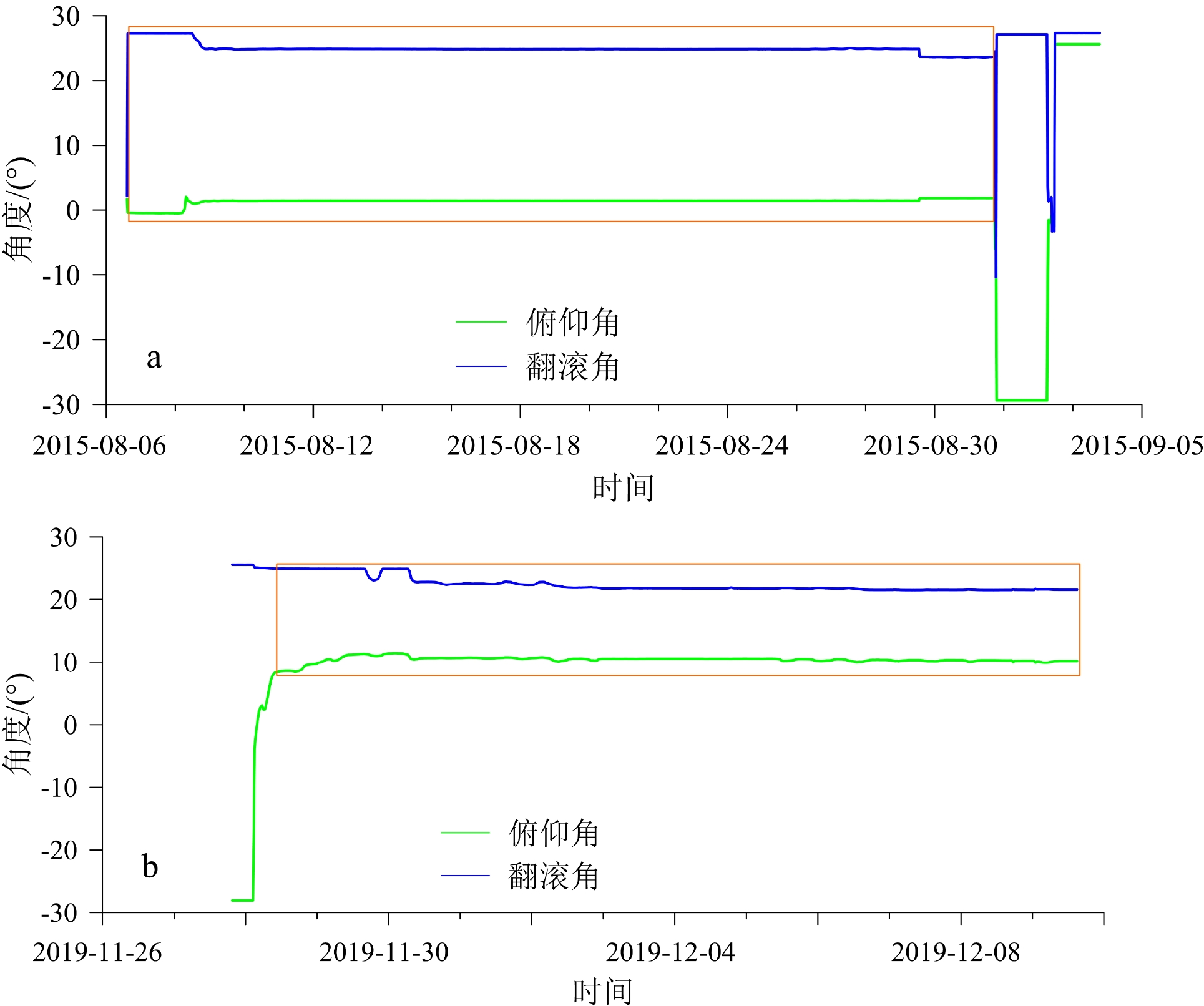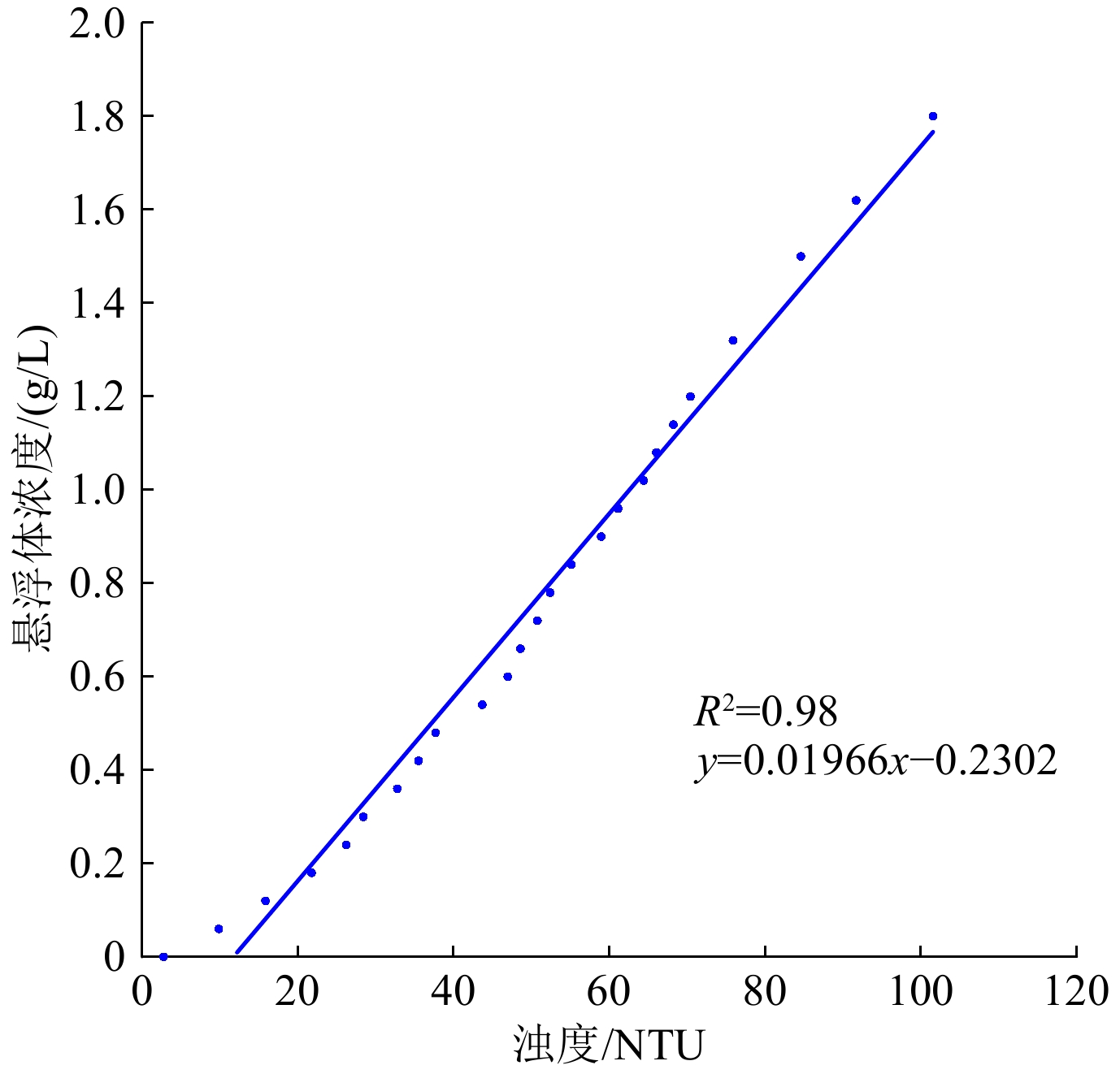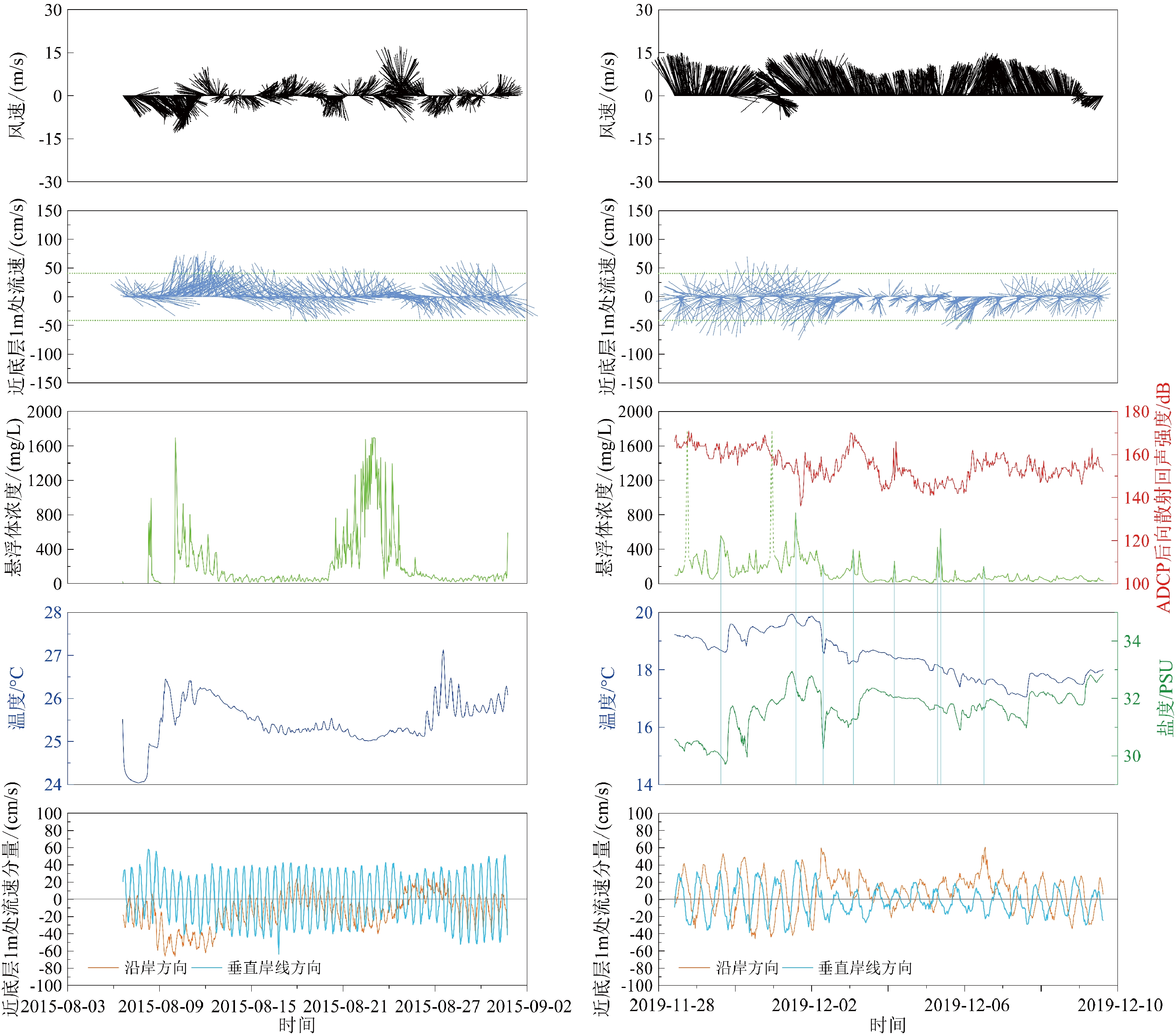Differences in sedimentary dynamic processes between summer typhoons and winter cold waves on the inner shelf of the East China Sea: Insights from in-situ observations
-
摘要:
在全球变暖的背景下,台风活动在未来如何发展是关系到人类社会安全的重大问题之一。受器测记录时间长度的限制,我们对于台风长期的发展与演化机制的认识还不充分。从东海内陆架泥质区的沉积记录中提取台风信息,是了解几千年来影响我国的台风演变规律的有效手段。但是,其他极端事件,尤其是冬季寒潮,会影响台风沉积事件识别的准确性。台风与冬季寒潮大风沉积事件的辨识也是台风活动重建的难点之一。利用布放在东海内陆架泥质区的四脚架观测系统,分别获取了台风“天鹅”和冬季寒潮大风期间的海水温度、盐度、悬浮体浓度和海流等数据,并结合近海观测浮标的风速、风向和波浪等数据,探讨了台风与冬季寒潮沉积动力过程的差异。结果表明,台风与冬季寒潮在风向、有效波高和近底层流速变化上有一定的相似性,但是台风较高的强度更容易引起近底层沉积物的再悬浮;台风经过时,高浓度悬浮体主要来自海底沉积物的再悬浮,而冬季寒潮期间高浓度悬浮体与长江入海物质的输入有关。由于台风和冬季寒潮近底层海流流向的差异,在东海内陆架泥质区向海一侧边缘沉积记录中的砂层可能代表了台风事件沉积,是研究台风活动规律的良好研究材料。研究结果为从东海泥质区沉积记录中提取更准确的台风信息提供了科学参考。
Abstract:One of the major challenges addressing human life safety in the context of global warming is how typhoon activity may develop in the future. Our understanding of typhoon long-term development and evolution mechanisms is limited by the duration of instrumental recording. Extraction of typhoon information from sedimentary records in the muddy area of the East China Sea inner shelf is an effective method for understanding the evolution patterns of typhoons that have impacted China over the past thousands of years. The precision of typhoon event detection, however, might be affected by other extreme events, such as winter cold waves. One of the difficulties in reconstructing typhoon activity is to identify typhoon and winter cold wave deposition events. Using a quadripod observation system placed in the muddy area of the East China Sea inner shelf, seawater temperature, salinity, suspended sediment concentration, and currents during Typhoon Goni and winter cold waves were measured, and the differences in sedimentary dynamic processes between typhoons and winter cold waves were then discussed by combining wind speed, wind direction, and wave data from offshore observation buoys. Observations on typhoons and winter cold waves showed certain similarities in the changes in wind direction, significant wave height, and near-bottom current velocity, but typhoons′ higher strength made it easier to resuspend seabed sediments. Typhoon-related high suspended sediment concentrations are mostly caused by the resuspension of seabed sediments, whereas high suspended sediment concentrations during winter cold waves are primarily caused by Yangtze River discharge. Sand layers in the sedimentary record of the seaward side edge of the inner shelf muddy area in the East China Sea are likely to represent typhoon event deposition because of the difference in the direction of the near-bottom current between typhoons and winter cold waves. Therefore, event deposition layers are good research materials for studying the variation patterns of typhoon activity. The findings of this study can be used as a scientific reference for extracting more accurate typhoon information from sedimentary records of the muddy area in the East China Sea.
-
Key words:
- typhoon /
- winter cold wave /
- in-situ observation /
- East China Sea
-

-
表 1 东海站6号和20号浮标分别在2015年台风“天鹅”和2019年冬季寒潮期间的观测数据
Table 1. Observation data of buoys No. 6 and No. 20 in the East China Sea during Typhoon Goni in 2015 and winter cold waves in 2019, respectively
观测指标 2015年8月 2019年11—12月 范围 平均值 范围 平均值 有效波高/m 1.6~4.5 3.0 1.1~3.9 2.2 有效波周期/s 7.0~26.9 8.6 4.4~8.1 6.2 10分钟平均风速/(m/s) 5.7~18.9 11.4 10.8~18.0 13.2 10分钟平均风向/(°) 0~359.0 226.6 1.0~358.0 254.1 流速/(cm/s) 16.2~78.3 42.0 0.8~68.6 19.2 流向/(°) 0~346.0 209.4 0~359.0 133.7 表 2 四脚架在2015年台风“天鹅”和2019年冬季寒潮期间的观测数据
Table 2. Observation data of quadripod during Typhoon Goni in 2015 and winter cold waves in 2019
观测指标 2015年8月 2019年11—12月 范围 平均值 范围 平均值 流速/(cm/s) 3.6~55.2 29.1 6.7~64.7 29.3 悬浮体浓度/(mg/L) 56.4~1691.9 606.6 27.3~823.7 149.8 沿岸方向流速/(cm/s) −42.7~24.4 −12.9 −42.1~60.7 13.0 垂直岸线方向流速/(cm/s) −39.4~46.0 6.4 −36.0~44.3 −2.9 注:流速沿岸向西南方向为正值,垂直岸线向海方向为正值。 -
[1] Peduzzi P, Chatenoux B, Dao H, et al. Global trends in tropical cyclone risk[J]. Nature Climate Change, 2012, 2(4): 289-294. doi: 10.1038/nclimate1410
[2] Milliman J D, Lin S W, Kao S J, et al. Short-term changes in seafloor character due to flood-derived hyperpycnal discharge: Typhoon Mindulle, Taiwan, July 2004[J]. Geology, 2007, 35(9): 779-782. doi: 10.1130/G23760A.1
[3] Siswanto E, Ishizaka J, Morimoto A, et al. Ocean physical and biogeochemical responses to the passage of Typhoon Meari in the East China Sea observed from Argo float and multiplatform satellites[J]. Geophysical Research Letters, 2008, 35(15): L15604. doi: 10.1029/2008GL035040
[4] Li Y H, Ye X, Wang A J, et al. Impact of Typhoon Morakot on chlorophyll a distribution on the inner shelf of the East China Sea[J]. Marine Ecology Progress Series, 2013, 483: 19-29. doi: 10.3354/meps10223
[5] Woodruff J D, Irish J L, Camargo S J. Coastal flooding by tropical cyclones and sea-level rise[J]. Nature, 2013, 504(7478): 44-52. doi: 10.1038/nature12855
[6] Wang B, Chen J F, Jin H Y, et al. Diatom bloom-derived bottom water hypoxia off the Changjiang estuary, with and without typhoon influence[J]. Limnology and Oceanography, 2017, 62(4): 1552-1569. doi: 10.1002/lno.10517
[7] Lu J, Jiang J B, Li A C, et al. Impact of Typhoon Chan-hom on the marine environment and sediment dynamics on the inner shelf of the East China Sea: In-situ seafloor observations[J]. Marine Geology, 2018, 406: 72-83. doi: 10.1016/j.margeo.2018.09.009
[8] Elsner J B, Liu K B. Examining the ENSO-typhoon hypothesis[J]. Climate Research, 2003, 25(1): 43-54.
[9] 苏纪兰. 中国近海水文[M]. 北京: 海洋出版社, 2005: 192-249
SU Jilan. Hydrography of China Seas[M]. Beijing: Ocean Press, 2005: 192-249.
[10] Zhou C, Chen P Y, Yang S F, et al. The impact of Typhoon Lekima (2019) on East China: a postevent survey in Wenzhou City and Taizhou City[J]. Frontiers of Earth Science, 2022, 16(1): 109-120. doi: 10.1007/s11707-020-0856-7
[11] Mei W, Xie S P. Intensification of landfalling typhoons over the northwest Pacific since the late 1970s[J]. Nature Geoscience, 2016, 9(10): 753-757. doi: 10.1038/ngeo2792
[12] Knutson T R, Sirutis J J, Garner S T, et al. Simulated reduction in Atlantic hurricane frequency under twenty-first-century warming conditions[J]. Nature Geoscience, 2008, 1(6): 359-364. doi: 10.1038/ngeo202
[13] Knutson T R, McBride J L, Chan J, et al. Tropical cyclones and climate change[J]. Nature Geoscience, 2010, 3(3): 157-163. doi: 10.1038/ngeo779
[14] Wehner M F, Reed K A, Loring B, et al. Changes in tropical cyclones under stabilized 1.5 and 2.0 °C global warming scenarios as simulated by the Community Atmospheric Model under the HAPPI protocols[J]. Earth System Dynamics, 2018, 9(1): 187-195. doi: 10.5194/esd-9-187-2018
[15] Emanuel K A. Downscaling CMIP5 climate models shows increased tropical cyclone activity over the 21st century[J]. Proceedings of the National Academy of Sciences of the United States of America, 2013, 110(30): 12219-12224.
[16] Emanuel K. Response of global tropical cyclone activity to increasing CO2: Results from downscaling CMIP6 models[J]. Journal of Climate, 2021, 34(1): 57-70. doi: 10.1175/JCLI-D-20-0367.1
[17] Donnelly J P, Woodruff J D. Intense hurricane activity over the past 5, 000 years controlled by El Niño and the West African monsoon[J]. Nature, 2007, 447(7143): 465-468. doi: 10.1038/nature05834
[18] Wallace D J, Anderson J B. Evidence of similar probablility of intense hurricane strikes for the Gulf of Mexico over the late Holocene[J]. Geology, 2010, 38(6): 511-514. doi: 10.1130/G30729.1
[19] Tian Y, Fan D J, Zhang X L, et al. Event deposits of intense typhoons in the muddy wedge of the East China Sea over the past 150 years[J]. Marine Geology, 2019, 410: 109-121. doi: 10.1016/j.margeo.2018.12.010
[20] Yang Y, Piper D J W, Normandeau A, et al. A late Holocene shift of typhoon activity recorded by coastal sedimentary archives in eastern China[J]. Sedimentology, 2022, 69(2): 954-969. doi: 10.1111/sed.12934
[21] Liu J P, Li A C, Xu K H, et al. Sedimentary features of the Yangtze River-derived along-shelf clinoform deposit in the East China Sea[J]. Continental Shelf Research, 2006, 26(17-18): 2141-2156. doi: 10.1016/j.csr.2006.07.013
[22] Jia J J, Gao J H, Cai T L, et al. Sediment accumulation and retention of the Changjiang (Yangtze River) subaqueous delta and its distal muds over the last century[J]. Marine Geology, 2018, 401: 2-16. doi: 10.1016/j.margeo.2018.04.005
[23] Xiao S B, Li A C, Liu J P, et al. Coherence between solar activity and the East Asian winter monsoon variability in the past 8 000 years from Yangtze River-derived mud in the East China Sea[J]. Palaeogeography, Palaeoclimatology, Palaeoecology, 2006, 237(2-4): 293-304. doi: 10.1016/j.palaeo.2005.12.003
[24] Xu K H, Milliman J D, Li A C, et al. Yangtze- and Taiwan-derived sediments on the inner shelf of East China Sea[J]. Continental Shelf Research, 2009, 29(18): 2240-2256. doi: 10.1016/j.csr.2009.08.017
[25] Liu X T, Li A C, Dong J, et al. Provenance discrimination of sediments in the Zhejiang-Fujian mud belt, East China Sea: Implications for the development of the mud depocenter[J]. Journal of Asian Earth Sciences, 2018, 151: 1-15. doi: 10.1016/j.jseaes.2017.10.017
[26] 李安春, 张凯棣. 东海内陆架泥质沉积体研究进展[J]. 海洋与湖沼, 2020, 51(4): 705-727 doi: 10.11693/hyhz20200500145
LI Anchun, ZHANG Kaidi. Research progress of mud wedge in the inner continental shelf of the East China Sea[J]. Oceanologia et Limnologia Sinica, 2020, 51(4): 705-727. doi: 10.11693/hyhz20200500145
[27] Xu K H, Li A C, Liu J P, et al. Provenance, structure, and formation of the mud wedge along inner continental shelf of the East China Sea: A synthesis of the Yangtze dispersal system[J]. Marine Geology, 2012, 291-294: 176-191. doi: 10.1016/j.margeo.2011.06.003
[28] Pang C G, Li K, Hu D X. Net accumulation of suspended sediment and its seasonal variability dominated by shelf circulation in the Yellow and East China Seas[J]. Marine Geology, 2016, 371: 33-43. doi: 10.1016/j.margeo.2015.10.017
[29] Chen D X, He L, Liu F F, et al. Effects of typhoon events on chlorophyll and carbon fixation in different regions of the East China Sea[J]. Estuarine, Coastal and Shelf Science, 2017, 194: 229-239. doi: 10.1016/j.ecss.2017.06.026
[30] Keen T R, Bentley S J, Chad Vaughan W, et al. The generation and preservation of multiple hurricane beds in the northern Gulf of Mexico[J]. Marine Geology, 2004, 210(1-4): 79-105. doi: 10.1016/j.margeo.2004.05.022
[31] Zhou X, Liu Z H, Yan Q, et al. Enhanced tropical cyclone intensity in the Western North Pacific during warm periods over the last two Millennia[J]. Geophysical Research Letters, 2019, 46(15): 9145-9153. doi: 10.1029/2019GL083504
[32] Yang S L, Bouma T J, Xu K H, et al. Storms dominate the erosion of the Yangtze Delta and southward sediment transport[J]. Science Bulletin, 2023, 68(6): 553-556. doi: 10.1016/j.scib.2023.03.005
[33] Lu J, Li A C, Dong J, et al. Impact of Typhoon Talim on surface sediment records on the East China Sea continental shelf[J]. Estuarine, Coastal and Shelf Science, 2021, 259: 107479. doi: 10.1016/j.ecss.2021.107479
[34] Li Y H, Wang A J, Qiao L, et al. The impact of typhoon Morakot on the modern sedimentary environment of the mud deposition center off the Zhejiang–Fujian coast, China[J]. Continental Shelf Research, 2012, 37: 92-100. doi: 10.1016/j.csr.2012.02.020
[35] Bian C W, Jiang W S, Song D H. Terrigenous transportation to the Okinawa Trough and the influence of typhoons on suspended sediment concentration[J]. Continental Shelf Research, 2010, 30(10-11): 1189-1199. doi: 10.1016/j.csr.2010.03.008
[36] Bian C W, Jiang W S, Quan Q, et al. Distributions of suspended sediment concentration in the Yellow Sea and the East China Sea based on field surveys during the four seasons of 2011[J]. Journal of Marine Systems, 2013, 121-122: 24-35. doi: 10.1016/j.jmarsys.2013.03.013
[37] 秦蕴珊, 赵一阳, 陈丽蓉, 等. 东海地质[M]. 北京: 科学出版社, 1987: 29-136
QIN Yunshan, ZHAO Yiyang, CHEN Lirong, et al. Geology of the East China Sea[M]. Beijing: Science Press, 1987: 29-136.
[38] Liu J, Qiu J D, Saito Y, et al. Formation of the Yangtze Shoal in response to the post-glacial transgression of the paleo-Yangtze (Changjiang) estuary, China[J]. Marine Geology, 2020, 423: 106080. doi: 10.1016/j.margeo.2019.106080
[39] Xu J S, Wang N, Li G X, et al. The dynamic responses of flow and near-bed turbidity to typhoons on the continental shelf of the East China Sea: field observations[J]. Geological Journal, 2016, 51: 12-21. doi: 10.1002/gj.2804
[40] Lu J, Li A C, Zhang J, et al. Sedimentary record off the Yangtze River estuary and its response to typhoons and human activities over the past 70 years[J]. Regional Studies in Marine Science, 2023, 65: 103074. doi: 10.1016/j.rsma.2023.103074
[41] 杨作升, 郭志刚, 王兆祥, 等. 黄东海陆架悬浮体向其东部深海区输送的宏观格局[J]. 海洋学报, 1992, 14(2): 81-90
YANG Zuosheng, GUO Zhigang, WANG Zhaoxiang, et al. Basic pattern of transport of suspended matter from the Yellow Sea and East China Sea to the eastern deep seas[J]. Acta Oceanologica Sinica, 1992, 14(2): 81-90.
[42] Hoshika A, Tanimoto T, Mishima Y, et al. Variation of turbidity and particle transport in the bottom layer of the East China Sea[J]. Deep Sea Research Part II: Topical Studies in Oceanography, 2003, 50(2): 443-455. doi: 10.1016/S0967-0645(02)00462-9
[43] Liu J T, Lee J, Yang R J, et al. Coupling between physical processes and biogeochemistry of suspended particles over the inner shelf mud in the East China Sea[J]. Marine Geology, 2021, 442: 106657. doi: 10.1016/j.margeo.2021.106657
-




 下载:
下载:




